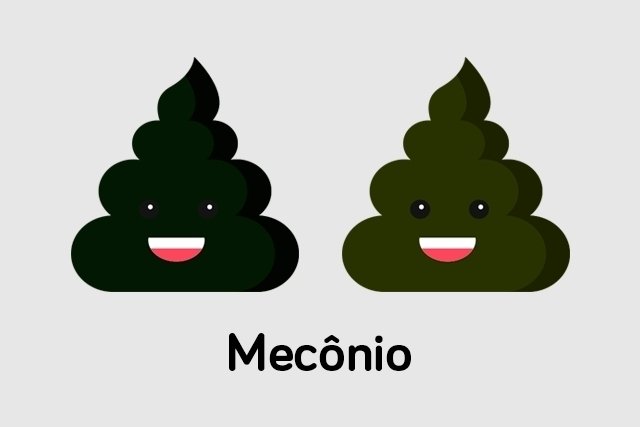“Meconium” is the name given to the first feces that are formed in the baby’s intestine by bile salts and other materials, it has a dark green color and is consistent and sticky.
The baby normally eliminates meconium in the first 24 to 36 hours after birth, stimulated by breastfeeding and this is important, as it is a sign that the intestine is working well. Premature babies weighing less than 1500g can eliminate meconium only after 48 hours of life.
However, in some cases, the elimination of meconium may not occur, take longer or occur before birth, which may cause health problems for the baby such as pneumonia and intestinal paralysis.

Characteristics of meconium
At first, the meconium is dark green in color, consistent and sticky. Around the 3rd to 4th day after birth, the consistency of the stool changes and begins to have a greenish-yellow color and a more liquid consistency. At this stage, the baby begins to evacuate many times a day, especially if it is exclusively breastfed and on demand, that is, according to the newborn’s wishes.
If the meconium is not eliminated within the first 24 to 36 hours, it may indicate that there is a problem with the baby and this is usually evaluated before discharge from the maternity ward, which only happens when the baby eliminates the first meconium.
Why meconium is not eliminated
Some situations during pregnancy, such as maternal diabetes, reduced oxygen supply to the baby and pregnancies lasting more than 42 weeks, can cause changes in the way meconium is eliminated by the baby. The main changes are:
Meconium aspiration
Reduced oxygen in the mother’s belly can cause stress in the baby, known as fetal distress, causing meconium to be released before birth. With this, the baby aspirates the meconium that is in the amniotic fluid, which is the liquid that surrounds the baby in the mother’s belly. Understand better about fetal suffering.
The aspiration of meconium by the baby is called meconium aspiration syndrome and normally the symptoms of inhalation are: rapid breathing, difficulty breathing, changes in the heartbeat, bluish coloring of the skin, nails and mouth, long and stained nails and dry, flaking skin.
Some situations can cause aspiration of meconium by the baby, such as pregnancy longer than 42 weeks, fetal distress, changes in the umbilical cord, mothers who smoke, have diabetes, have high blood pressure and babies born by cesarean section.
Treatment: Most babies who aspirate meconium are treated and improve within 5 to 7 days. If the baby doesn’t have difficulty breathing, she can stay with her mother in the room. Depending on the severity of the meconium aspiration, the baby may need to stay in an incubator, receive oxygen therapy, and be treated with antibiotics and surfactant. In some cases, it is necessary to remove meconium from babies’ mouths, noses and lungs.
Sequels: in some cases, meconium aspiration can lead to some sequelae such as pneumonia, decreased production of pulmonary surfactant, which is an important liquid for breathing, changes in heart function and seizures.

Bowel obstruction
When meconium is not eliminated or when the volume of meconium that is eliminated is very low, the baby’s intestine may be obstructed. This change in the functioning of the baby’s intestines may be caused by changes in the shape of the intestine or difficulties in eliminating meconium.
When the baby’s intestine is blocked, symptoms such as vomiting and a swollen belly may appear, and the diagnosis can be made at two different times: during pregnancy, through ultrasound, and after the baby is born, with x-ray and biopsy. which is an exam to assess the health of the body’s tissues, in the baby’s intestine.
Treatment: the treatment of obstructed intestines is carried out after the baby is born and varies according to the assessment of the medical team, the type and degree of blockage in the baby’s intestines. When there is a change in the shape of the intestine, treatment is done with surgery and if there are difficulties in eliminating the meconium, the baby’s intestine is usually washed.
Sequels: if there is a delay in diagnosing or treating the obstruction, there may be a loss of blood circulation in the baby’s intestine and this can cause necrosis, which is the death of intestinal cells, which is a serious situation.

Sign up for our newsletter and stay up to date with exclusive news
that can transform your routine!
Warning: Undefined array key "title" in /home/storelat/public_html/wp-content/plugins/link-whisper-premium/templates/frontend/related-posts.php on line 12
Warning: Undefined array key "title_tag" in /home/storelat/public_html/wp-content/plugins/link-whisper-premium/templates/frontend/related-posts.php on line 13




